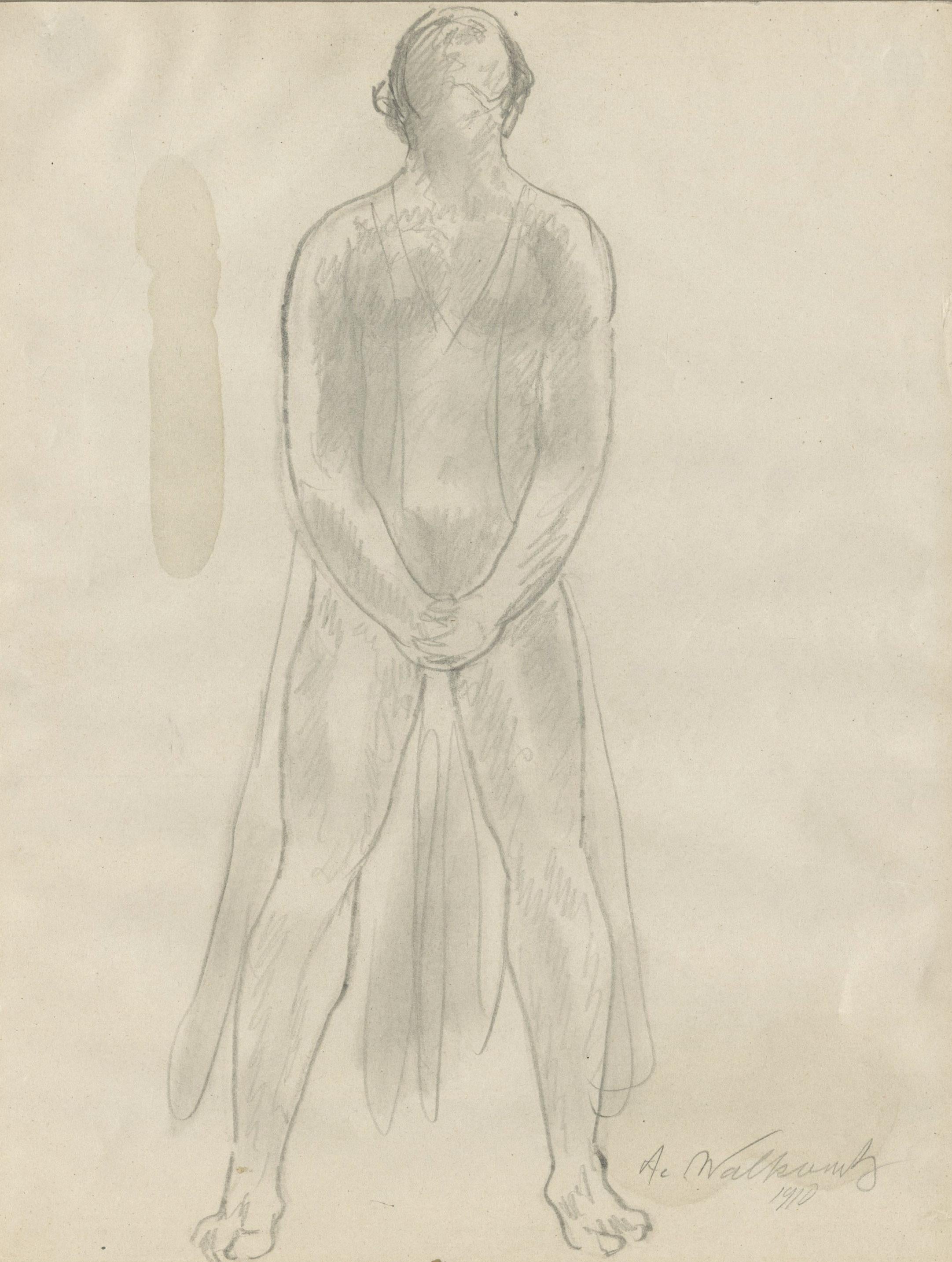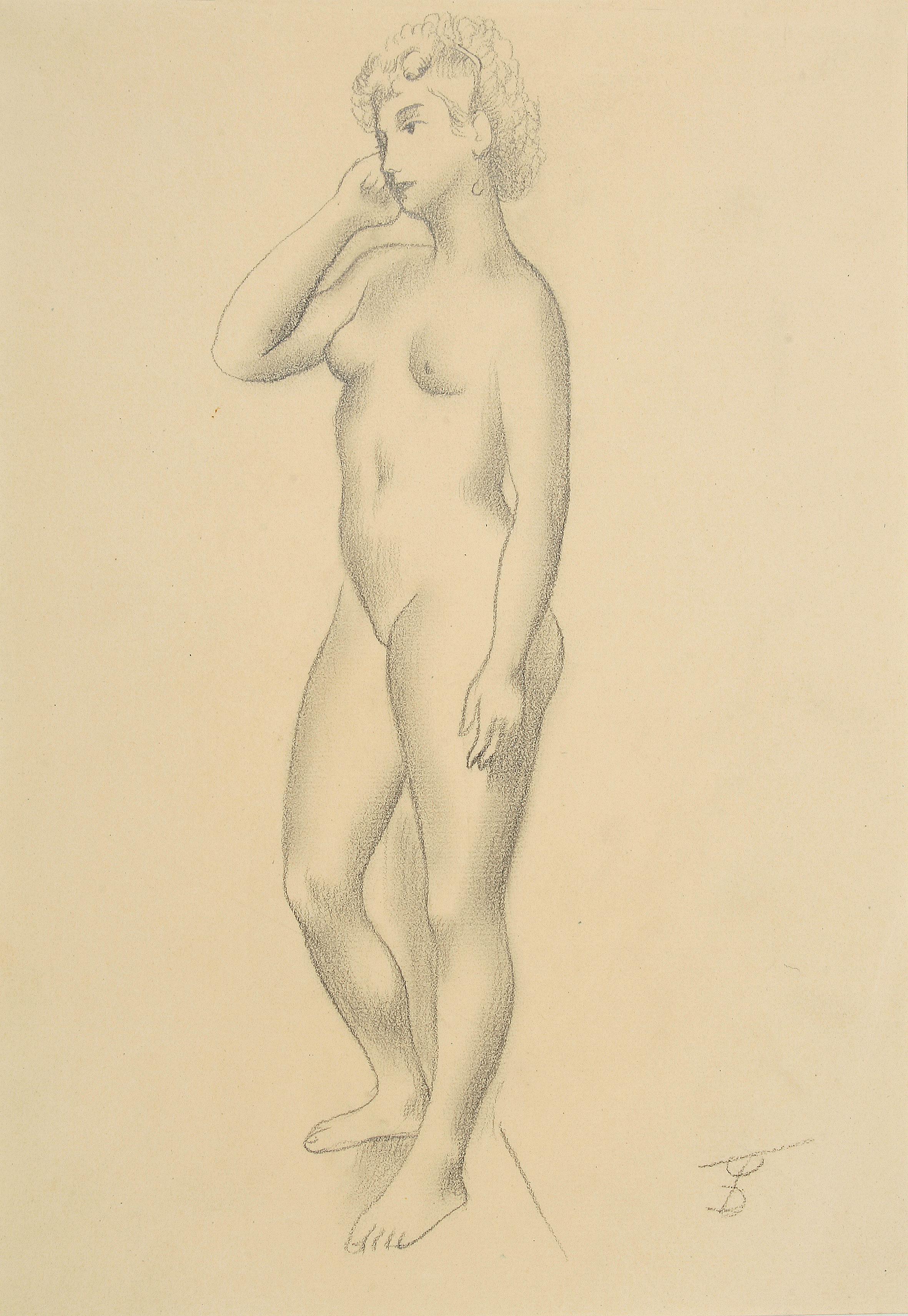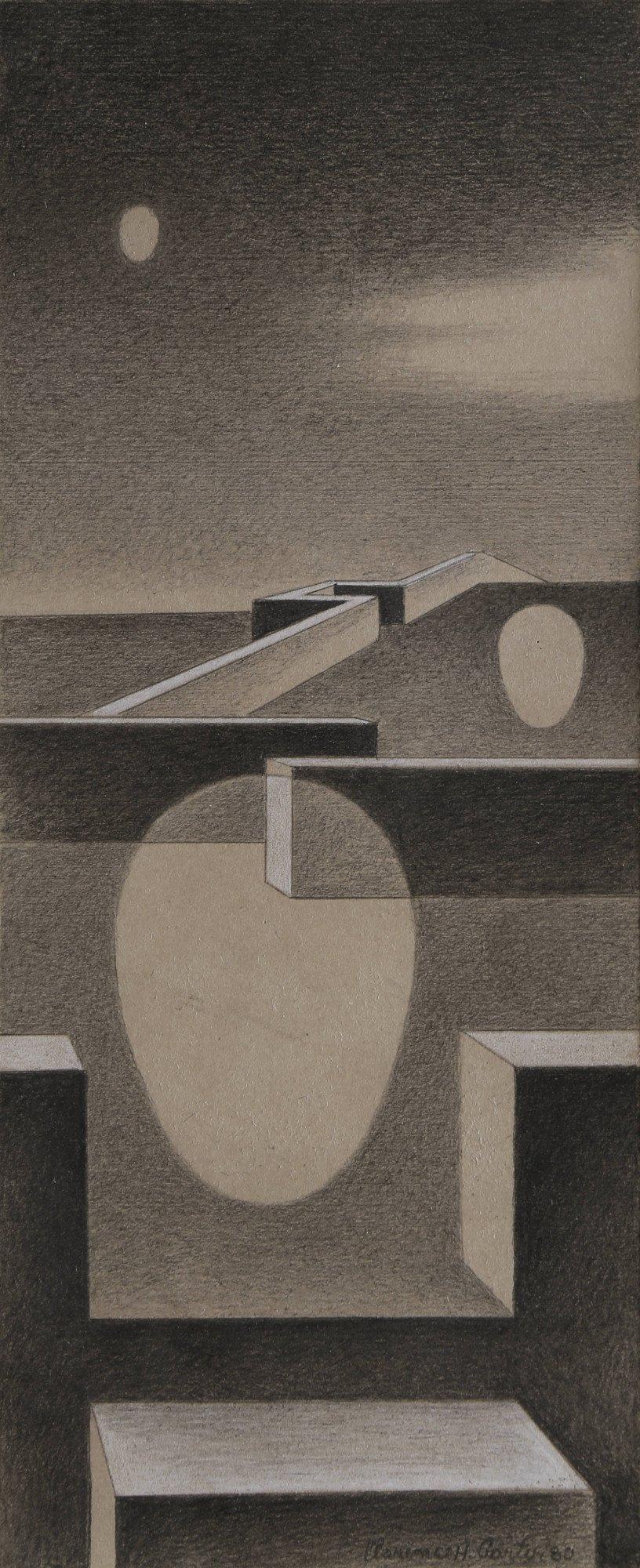E. Ambrose WebsterVolunteer Firemen, Provincetownc. 1933
c. 1933
About the Item
- Creator:E. Ambrose Webster (1869 - 1935, American)
- Creation Year:c. 1933
- Dimensions:Height: 6.5 in (16.51 cm)Width: 10 in (25.4 cm)
- Medium:
- Movement & Style:
- Period:
- Condition:Framed: 19 x 22".
- Gallery Location:Fairlawn, OH
- Reference Number:
E. Ambrose Webster
E. Ambrose Webster was among our first and most forceful modern painters, and is one of America’s greatest interpreters of Fauvism. His masterworks are in such public collections as the Corcoran and the Hirshhorn Museum and Sculpture Garden. In recent years his work has figured prominently in publications and exhibitions at Babcock Galleries’ E. Ambrose Webster: A Retrospective of Paintings and The Armory Show Years of E. Ambrose Webster, in the High Art Museum’s The Advent of Modernism, 1987 and in William Gerdts’ 1997 landmark work The Color of Modernism: The American Fauves and, more recently in 2007–08, the Greenville County Museum of Art’s retrospective exhibition E. Ambrose Webster: Pioneer Modernist. Webster’s dynamic career spanned 40 years and found him consistently in the middle of the Modernist movement. He traveled and exhibited widely, knew important artists everywhere, was acclaimed by his peers and created some of the finest and most adventurous paintings of his time.
Webster was a consummate American Modernist painter. After initial studies under Edmund Tarbell and Frank Benson in Boston, he spent nearly three years in Europe absorbing the latest developments in the Post-Impressionist art world. By 1900 he returned to the United States, and, having developed his own original idiom, became a prominent member of the progressive art community. Over the years he traveled widely in France, Spain, Italy, North Africa, the Azore Islands, Jamaica and Bermuda, seeking the sunlight-heightened color which inspired him. In 1906, while painting in the Caribbean, he exhibited a work which secured the Musgrave Silver Medal from the Institute of Jamaica. By 1913 he was exhibiting in Boston and Cleveland with Charles Hovey Pepper, Carl G. Cutler and Maurice Prendergast. Webster also participated in the 1913 International Exhibition of Modern Art (The Armory Show) and showed in New York thereafter.
(Biography provided by Driscoll Babcock Galleries)- ShippingRetrieving quote...Ships From: Fairlawn, OH
- Return PolicyA return for this item may be initiated within 10 days of delivery.
- Reclining Female NudeBy Emil GansoLocated in Fairlawn, OHReclining Female Nude Charcoal on paper, c. 1933 Signed lower right (see photo) Provenance: Weyhe Gallery, New York (Ganso's dealer 1925-1941) Joseph Mark Erdelac, Cleveland, noted collector who had a large collection of Ganso works Ganso was born in Germany in 1895. At age 14, he apprenticed to a baker and then worked his way to America when he was 17. He worked in bakeries in Scranton, Pennsylvania; and Cincinnati and Akron, Ohio. By 1916, Ganso out of a job, and was living the life of a bohemian in New York City, sometimes on less than 30 cents a week.1 In 1921, Ganso painted a realistic nude on a bedsheet, and was forced by the police to remove it from an exhibition. The bedsheet with the painting was later stolen. He soon had a job baking again at $140 a month, and with time to spare for painting and study. Ganso quit baking in 1925 when a New York dealer gave him financial backing of $50 a week. Ganso prospered from his art after that. His work is in over 15 American museums, and the Print Club of Cleveland awarded him a $500 purchase prize for a wood engraving. A versatile artist, he painted a variety of subjects. (from a profile written by Clyde Singer...Category
1930s American Modern Nude Drawings and Watercolors
MaterialsGraphite
- Seated CoupleBy Raphael SoyerLocated in Fairlawn, OHInspiration (Seated Couple) Graphite on paper, c. 1967 Signed twice in pencil by the artist on recto (see photos) Condition: Excellent Image size: 13 x 16 inches Note: Although not t...Category
1960s American Modern Figurative Drawings and Watercolors
MaterialsGraphite
- Isadora DuncanBy Abraham WalkowitzLocated in Fairlawn, OHIsadora Duncan Graphite with grey wash on paper mounted to cardstock Signed and dated in pencil lower right (see photo) Provenance: Charlotte Bergman, f...Category
1910s American Modern Figurative Drawings and Watercolors
MaterialsGraphite
- Pablo CasalsBy August F. BiehleLocated in Fairlawn, OHPablo Casals Graphite on paper, 1963 Signed in pencil lower right (see photo) Sheet size: 11 5/8 x 8 inches Condition: glue residue in all four corners of the sheet Drawn from life during an appearance at Carnegie Hall with the Cleveland Orchestra...Category
1960s American Modern Figurative Drawings and Watercolors
MaterialsGraphite
- Untitled (Study for The Aerialists)By John Steuart CurryLocated in Fairlawn, OHUntitled (Study for The Aerialists) Graphite on paper, 1932 Signed lower right in pencil: "John Steuart Curry" Dated: 1932 in pencil Exhibited: Schroeder Romero & Shredder, NYC (la...Category
1930s American Modern Figurative Drawings and Watercolors
MaterialsGraphite
- Woman with Bicycle: Two ViewsBy Frank DuveneckLocated in Fairlawn, OHWoman with Bicycle: Two Views Graphite on paper, c. 1890 Unsigned Graphite study of standing female nude verso Provenance: Rookwood Pottery Factory ...Category
1890s American Realist Figurative Drawings and Watercolors
MaterialsGraphite
- Stehender Akt / Standing NudeBy August Wilhelm DresslerLocated in Wien, 9August Dressler is one of the painters of the New Objectivity. He is one of the lesser-known artists of the Weimar era, but he too, like his famous contemporaries Georg Grosz, John H...Category
20th Century Modern Figurative Drawings and Watercolors
MaterialsPaper, Graphite
- Study for Worlds Beyond - Surrealist graphite drawing, Ohio artistBy Clarence Holbrook CarterLocated in Beachwood, OHClarence Holbrook Carter (American, 1904-2000) Study for Worlds Beyond, 1980 Graphite, collage and white heightening on illustration board Signed and dated lower right 10.75 x 4.5 in...Category
1980s American Modern Figurative Drawings and Watercolors
MaterialsGraphite
- Women's Corner, Along the Cuyahoga River, Early 20th Century Cleveland SchoolBy Frank WilcoxLocated in Beachwood, OHFrank Nelson Wilcox (American, 1887-1964) Women's Corner, Along the Cuyahoga River, c. 1916 Watercolor and graphite on paper 21 x 29 inches Frank Nelson Wilcox (October 3, 1887 – April 17, 1964) was a modernist American artist and a master of watercolor. Wilcox is described as the "Dean of Cleveland School painters," though some sources give this appellation to Henry Keller or Frederick Gottwald. Wilcox was born on October 3, 1887 to Frank Nelson Wilcox, Sr. and Jessie Fremont Snow Wilcox at 61 Linwood Street in Cleveland, Ohio. His father, a prominent lawyer, died at home in 1904 shortly before Wilcox' 17th birthday. His brother, lawyer and publisher Owen N. Wilcox, was president of the Gates Legal Publishing Company or The Gates Press. His sister Ruth Wilcox was a respected librarian. In 1906 Wilcox enrolled from the Cleveland School of Art under the tutelage of Henry Keller, Louis Rorimer, and Frederick Gottwald. He also attended Keller's Berlin Heights summer school from 1909. After graduating in 1910, Wilcox traveled and studied in Europe, sometimes dropping by Académie Colarossi in the evening to sketch the model or the other students at their easels, where he was influenced by French impressionism. Wilcox was influenced by Keller's innovative watercolor techniques, and from 1910 to 1916 they experimented together with impressionism and post-impressionism. Wilcox soon developed his own signature style in the American Scene or Regionalist tradition of the early 20th century. He joined the Cleveland School of Art faculty in 1913. Among his students were Lawrence Edwin Blazey, Carl Gaertner, Paul Travis, and Charles E. Burchfield. Around this time Wilcox became associated with Cowan Pottery. In 1916 Wilcox married fellow artist Florence Bard, and they spent most of their honeymoon painting in Berlin Heights with Keller. They had one daughter, Mary. In 1918 he joined the Cleveland Society of Artists, a conservative counter to the Bohemian Kokoon Arts Club, and would later serve as its president. He also began teaching night school at the John Huntington Polytechnic Institute at this time, and taught briefly at Baldwin-Wallace College. Wilcox wrote and illustrated Ohio Indian Trails in 1933, which was favorably reviewed by the New York Times in 1934. This book was edited and reprinted in 1970 by William A. McGill. McGill also edited and reprinted Wilcox' Canals of the Old Northwest in 1969. Wilcox also wrote, illustrated, and published Weather Wisdom in 1949, a limited edition (50 copies) of twenty-four serigraphs (silk screen prints) accompanied by commentary "based upon familiar weather observations commonly made by people living in the country." Wilcox displayed over 250 works at Cleveland's annual May Show. He received numerous awards, including the Penton Medal for as The Omnibus, Paris (1920), Fish Tug on Lake Erie (1921), Blacksmith Shop (1922), and The Gravel Pit (1922). Other paintings include The Trailing Fog (1929), Under the Big Top (1930), and Ohio Landscape...Category
1910s American Modern Figurative Drawings and Watercolors
MaterialsGraphite, Watercolor
- Cows by Woodland Pond, Toledo, Ohio, Early 20th Century Cleveland SchoolBy Frank WilcoxLocated in Beachwood, OHFrank Nelson Wilcox (American, 1887-1964) Cows by Woodland Pond, Toledo, Ohio, c. 1920 Watercolor and graphite on board Signed lower right 22 x 30 inches Frank Nelson Wilcox (October 3, 1887 – April 17, 1964) was a modernist American artist and a master of watercolor. Wilcox is described as the "Dean of Cleveland School painters," though some sources give this appellation to Henry Keller or Frederick Gottwald. Wilcox was born on October 3, 1887 to Frank Nelson Wilcox, Sr. and Jessie Fremont Snow Wilcox at 61 Linwood Street in Cleveland, Ohio. His father, a prominent lawyer, died at home in 1904 shortly before Wilcox' 17th birthday. His brother, lawyer and publisher Owen N. Wilcox, was president of the Gates Legal Publishing Company or The Gates Press. His sister Ruth Wilcox was a respected librarian. In 1906 Wilcox enrolled from the Cleveland School of Art under the tutelage of Henry Keller, Louis Rorimer, and Frederick Gottwald. He also attended Keller's Berlin Heights summer school from 1909. After graduating in 1910, Wilcox traveled and studied in Europe, sometimes dropping by Académie Colarossi in the evening to sketch the model or the other students at their easels, where he was influenced by French impressionism. Wilcox was influenced by Keller's innovative watercolor techniques, and from 1910 to 1916 they experimented together with impressionism and post-impressionism. Wilcox soon developed his own signature style in the American Scene or Regionalist tradition of the early 20th century. He joined the Cleveland School of Art faculty in 1913. Among his students were Lawrence Edwin Blazey, Carl Gaertner, Paul Travis, and Charles E. Burchfield. Around this time Wilcox became associated with Cowan Pottery. In 1916 Wilcox married fellow artist Florence Bard, and they spent most of their honeymoon painting in Berlin Heights with Keller. They had one daughter, Mary. In 1918 he joined the Cleveland Society of Artists, a conservative counter to the Bohemian Kokoon Arts Club, and would later serve as its president. He also began teaching night school at the John Huntington Polytechnic Institute at this time, and taught briefly at Baldwin-Wallace College. Wilcox wrote and illustrated Ohio Indian Trails in 1933, which was favorably reviewed by the New York Times in 1934. This book was edited and reprinted in 1970 by William A. McGill. McGill also edited and reprinted Wilcox' Canals of the Old Northwest in 1969. Wilcox also wrote, illustrated, and published Weather Wisdom in 1949, a limited edition (50 copies) of twenty-four serigraphs (silk screen prints) accompanied by commentary "based upon familiar weather observations commonly made by people living in the country." Wilcox displayed over 250 works at Cleveland's annual May Show. He received numerous awards, including the Penton Medal for as The Omnibus, Paris (1920), Fish Tug on Lake Erie (1921), Blacksmith Shop (1922), and The Gravel Pit (1922). Other paintings include The Trailing Fog (1929), Under the Big Top (1930), and Ohio Landscape...Category
1920s American Modern Figurative Drawings and Watercolors
MaterialsWatercolor, Graphite
- Der Fled Maus (Figurative Drawing of Costumed Man with Moon on Teal Paper)By Nicholas Kahn & Richard SelesnickLocated in Hudson, NYFigurative drawing of a costumed man with two moons on handmade teal colored paper "Der Fled Maus", made by Kahn & Selesnick in 2011 mixed media, graphite, and pastel handmade paper 17 x 17 inches in walnut vintage wood frame with 8ply mat 7.5 x 7.5 inches unframed This whimsical mixed media drawing on handmade teal colored paper was made by the creative duo Nicholas Kahn & Richard Selesnick as part of their series "Truppe Fledermaus", wherein the artists celebrate the carnivalesque with a cast of peculiar costumed characters. In this illustration, a cloaked figure stands in front of a door with the moon, in two different phases, appearng in the background. The artists' highly stylized approach adds an almost vintage touch. The drawing is complemented by a simple vintage walnut frame, and a sturdy wire across the back provides for easy hanging. About Truppe Fledermaus: Kahn & Selesnick’s latest project follows a fictitious cabaret troupe – Truppe Fledermaus (Bat Troupe) – who travel the countryside staging absurd and inscrutable performances in abandoned landscapes for an audience of no one. The playful but dire message presented by the troupe is of impending ecological disaster, caused by rising waters and a warming planet, the immediate consequences of which include the extinction of the Bat, a shamanistic figure representing both nature and humanity. In one sense, the entire cabaret troupe can be seen as a direct reflection of the artists themselves, both entities employing farce and black humor to engage utterly serious concerns. About Kahn & Selesnick: Nicholas Kahn and Richard Selesnick...Category
2010s Modern Figurative Drawings and Watercolors
MaterialsMixed Media, Handmade Paper, Pastel, Graphite
- Figure Study (Standing Male- Torso)By Harold HaydonLocated in Chicago, ILA black and white figure study of a nude male, from 1951, by artist Harold Haydon. Matted to 24" x 20". Provenance: Estate of the Artist. Estate stamped on reverse. Harold Emers...Category
1950s American Modern Figurative Drawings and Watercolors
MaterialsGraphite






